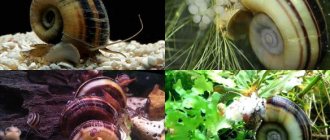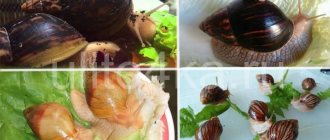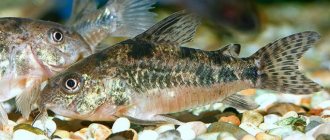04/20/2019Shellfish0
Coil snails or Planorbids belong to the family of gastropods, order Pulmonata, a group of freshwater mollusks. Often they end up in an aquarium completely by accident - with plants or other inhabitants. The coils multiply quickly, hang on the walls of the container and perform the function of “orderlies”.
- 1 Description and natural habitat
- 2 Mr. Tail recommends: popular varieties of Coils
- 3 Basics of keeping an aquarium
- 4 Feeding
- 5 Benefits of Coils and breeding
- 6 Harm from Coils in an aquarium and how to get rid of them
- 7 Myths about Reels
Description and natural habitat
Snails are found all over the world, living in fresh, shallow bodies of water with weak currents. They can live even in dirty and poorly oxygenated waters.
Depending on the type they have different sizes. Individuals have a spiral-shaped, twisted shell. The diameter of the shell is from 5 to 30 mm, and its thickness ranges from 1 to 3 mm. Their color can be varied: from translucent to spotted or striped. Movement is carried out thanks to the wide paw. They crawl on underwater objects and can also swim due to adhesion to the surface tension boundary of water. There are two tentacles on the head, and under them there are eyes.
Photo gallery of Snail Coils:
Mollusks have a pulmonary cavity, thanks to which they breathe air. The coils replenish its reserves by floating to the surface of the water. Near the pulmonary cavity there is a special skin lint that acts as gills when there is a lack of oxygen. In addition, even their covers are able to breathe.
The life expectancy of snails is short - on average 2-3 years.
Feeding
There is an opinion that coil snails in an aquarium harm plants. They are often seen sitting on dead greenery and blame the mollusks for what is happening. In fact, snails do not destroy, but eat sick, dying plants . The teeth of these gastropods are not developed enough to bite through a young healthy leaf. But the soft rotting one is quite pliable for their jaw, so this method of feeding suits them best.
Typically used to feed reels:
- zucchini;
- cucumber;
- cabbage;
- salad;
- spinach;
- dry food for fish.
Vegetables should be boiled for 1 minute immediately before feeding, and greens should be scalded with boiling water. Shellfish get most of their nutrition from food scraps left by fish.
Mr. Tail recommends: popular varieties of Coils
For aquarium keeping, the main choice is the Horny and Red Horny Coil. The table shows the most popular types.
| View | Geography of habitat | Description |
| Horny | Russia, Canada, Europe, Asia. | The diameter of the shell is no more than 35 mm, about 5 turns. Olive or pink shell color. Spends most of its life in the thickets of water bodies, feeding on rotting plants and animals. |
| Horny red | Asia, Europe, Transcaucasia, Siberia. | The shell is red, about 20 mm in diameter. Lifestyle and nutrition like that of a horny snail. |
| Far Eastern | Swampy terrain of East Asia. | The shell has an interesting striped wavy color. |
| Keeled | Europe, Siberia, Central Asia. | The shell has a seam dividing it in half. It is called the keel. The snail feeds on organic matter from the bottom of the pond. |
| Wrapped | Asia, Europe, Siberian reservoirs, Altai. | Transparent yellow shell with a diameter of no more than 10 mm. Adapts quickly to the environment and is prolific. |
Some species of snails are intermediate carriers for trematode parasites, which cause damage to the human circulatory system and can cause a dangerous disease - schistosomiasis.
Species diversity
There are several types of mollusks that have both some external similarities and differences:
- Horny
They live in well-overgrown reservoirs with stagnant water. The size of individuals reaches 3.5 cm. The shells are brownish in color, the body is a matching reddish-brown. Horny gastropods eat the remains of various foods that settle to the bottom. - Horny reds
Representatives of the species are small in size; even in nature, individuals do not grow more than 2 cm. They have a bright red shell, which looks beautiful against the background of plants, so you can keep these snails as decoration for a pond. In addition, these mollusks are excellent tank cleaners. - Far Eastern
This little East Asian guest, whose size does not exceed 1 cm, like other coils, is unpretentious. It has a red-brown shell with 5-6 curls. Its main diet is plants. - Keeled
The most common type of snail, more often than other snails, is found in domestic ponds. It often settles and takes root on its own, penetrating the aquarium on plant leaves and with particles of soil material. Individuals are painted in gray-brown tones. The main feature of keeled snails is that the width of their shell is much smaller than the diameter - with a width of 4 mm, the shell consists of 6-7 whorls and its diameter is about 2 cm. Like other coils, they search for food at the bottom, eat algae that covers the walls of the tank. - Wrapped
These mollusks are considered pests - their population increases exponentially, literally filling the container, damaging the biobalance, worsening the condition of the aquatic environment and soil. Individuals have a strong shell of a yellow, dirty hue, their size does not exceed 1 cm.
Aquarium Basics
Distinguished by their calm and peaceful character, the Coil snails are absolutely undemanding, since in nature they live in various bodies of water, but the following conditions will be favorable:
- Water temperature +22…+28 °C.
- Aeration and filtration are not important.
- Calm current.
- Presence of plants at the bottom.
- A lid is required to prevent crawling out and possible death of pets.
They get along easily with any small fish and red-eared turtles. Remove dead Coils immediately, as their decomposition spoils the water.
Rules of care
Since the coils are able to adapt to any conditions, they do not require special care. However, despite this, the optimal temperature range is from +22C to +28C. It is recommended to periodically add calcium to the water; its deficiency will be noticeable by the appearance of the shell. The aquarium must be closed, as the mollusks can crawl out of the water and die.
Sometimes it is difficult to understand whether a snail is alive or dead. To do this, they pull it out and evaluate the smell - the dead one smells of rot. Dead individuals must be removed immediately, as they cause water spoilage.
Benefits of Coils and Breeding
In addition to their unpretentiousness, these beautiful creatures perform important useful functions:
- Decorative. The coils are beautiful, together with other small fish, they create a harmonious aquarium world.
- Sanitary. Snails feed on rotten plants and leave healthy ones alone. They eat up the food that has fallen behind the fish, and also remove the film from the surface of the water and the walls.
- Contamination indicator. If the mollusks begin to actively reproduce, you should think about cleaning the aquarium or changing the water, and also reduce the amount of complementary food for the fish.
- Food for other inhabitants. Some living organisms can feed on these snails, their eggs and young.
Coils are hermaphrodites, they can reproduce without mating, 1-2 individuals can create a whole group. The caviar is a transparent film with black dots; its ripening period is about a month, then the cubs hatch. Masonry appears on any surface: on plant leaves, on glass, on stones.
Where do snails come from?
For those fish keepers who intentionally purchased shellfish, there is no question about where the snails in the tank came from. However, if there were no conscious purchases, then the question is quite logical - many aquarists, having discovered a lot of snails in the tank, are at a loss. The answer is simple - parasites in an aquarium are introduced from the outside, arriving in an artificial reservoir along with untreated substrate or living flora. Therefore, in order not to fight pests later, before immersing them in the aquarium, the plants are kept in a weak solution of potassium permanganate, which is destructive for small mollusks.
In other words, gastropods appear in two ways: with the help of an aquarist, or by penetrating along with vegetation. If the conditions in the tank are favorable, then the uninvited guests begin to multiply rapidly.
Harm from Coils in an aquarium and how to get rid of them
In addition to their benefits, snails can also cause harm. The main reasons for removing shellfish from aquariums are:
- Reproduction rate. If there is insufficient control over this process, the population will become huge, and other inhabitants will feel uncomfortable and closely coexist with the Coils.
- Food shortage. As soon as there are a lot of snails, there is not enough food for everyone, and they begin to eat healthy plants.
- Carriers of infections. Wild snails that accidentally enter an aquarium can cause illness in other underwater pets. When trying to cure them, they add medications, which kill the Coils.
- Inconvenience. A huge number of snails will fill all surfaces of the aquarium, which will not decorate the appearance and cause discomfort to its other inhabitants. The water will contain a large amount of their waste products.
In order to reduce harm from Coils, it is necessary to control their population. There are several withdrawal methods:
- Ancistrus colonization. These fish clean off any surface, thereby getting rid of snail eggs. But before that, you need to weigh all the benefits and harms for other inhabitants of the aquarium.
- Addition of macropods, tetradons. These representatives feed on shellfish. Before introducing them, you need to make sure they are compatible with other pets.
- Purchase macrobrachium shrimp. Like previous species, it eats snails. You need to be careful, as slow and small fish may be harmed.
- Manual removal. You can add a lettuce leaf, previously scalded with boiling water, or a darkened banana peel to the aquarium; after the snails have completely covered them, remove them.
- Removal with chemicals. They can be purchased in specialized stores. The other inhabitants are first evicted. But you need to remember that the composition of the water will still change and, most likely, the aquarium will have to be restarted.
- General washing of the aquarium, its surfaces and boiling of the soil. This method helps get rid of snails completely.
What to feed
They feed on non-living plants and leftover food, thereby helping to clean the aquarium. Or they themselves can become food for other inhabitants of the aquarium.
Most of all I like to “devour” small algae. The process of their feeding, the way they scrape off and eat the plant with their microscopic teeth, can be observed for a long time and with great interest. You can feed them with meat, various vegetables: cucumber, herbs, lettuce, but this is not necessary, since by eating algae they already receive everything they need for their existence. All raw food must be poured with boiling water for 5-10 minutes before being thrown into the container (this is done to kill unwanted microorganisms).
Myths about Reels
These snails are popular pets among aquarists. In this regard, many myths were born, such as:
- Coils damage healthy parts of plants. This is not true - they have weak jaws and are unable to chew through algae.
- Shellfish are carriers of diseases. There is some truth in this, but this mainly applies to wild individuals or those that got into the aquarium by accident. Therefore, you need to purchase proven snails from a specialized pet store.
- Rapid and uncontrolled reproduction. This is possible if there are no fish in the aquarium that eat shellfish, and are also very overfed. This process must be monitored.
In conclusion, we can say that in breeding aquarium snails, Katushek will bring more benefit than harm, and it can be minimized with proper care.
Reproduction
The coil is a hermaphrodite that can self-fertilize and further reproduce. Therefore, if you want to get a population of these snails, then you will only need to have a couple of individuals. The snail lays eggs on the inside of a leaf of an aquarium plant.
Basically, the population of snails in aquariums is regulated without the intervention of the aquarist, since aquarium fish happily eat young snails. But if the fish are full, then they won’t particularly touch small shellfish. If you notice a rapid increase in the snail population, this indicates that you are overfeeding your fish. Therefore, you just need to cut down the rations for the fish and use your hands to remove the snails from the jar.
There are cases when aquarists purposefully breed snails because they are used as food for some pets or fish (bots). In this case, there is no need to pour soil into the aquarium, as this will complicate the process of cleaning the aquarium. Place several types of floating plants (naiad, pistia, riccia, Java moss) in a jar. If you cannot find any, plant Vallisneria, Canadian elodea or hornwort. You can feed snails with dry fish food and scalded leaves of cabbage, lettuce and spinach.











